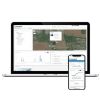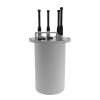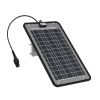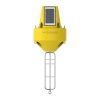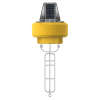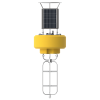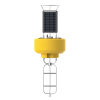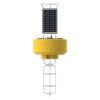NexSens X3 Environmental Data Logger
Features
- 4G LTE cellular, Iridium satellite, or dual telemetry options
- Marine anodized waterproof housing for deployment in harsh environments
- Uses WQData LIVE web datacenter for instant data access from any web browser
- Free ground shipping
- Expedited repair and warranty service
- Lifetime technical support
- More
The X3 is an all-in-one environmental data logger designed for both pole/wall mount and buoy-based applications. The three waterproof sensor ports are compatible with most environmental sensors including multi-parameter sondes, water quality sensors, temperature strings, ADCP’s, water level sensors, and weather stations. All connections are made with a simple thread-in connector, and the built-in sensor library automatically facilitates setup and configuration. Data is stored on common or independent schedules.
Power options include SP-Series Solar Power Packs, AC adapter, or external 12 VDC. Advanced power management combined with ultra-low sleep and run currents extend battery life and eliminate the need for multi-battery arrays or large solar charging systems. The X3 monitors itself while collecting environmental data - internal temperature, humidity, voltages and currents are constantly recorded, and failure alerts can be sent automatically to a predefined list of contacts.
Using Bluetooth or a USB adapter and CONNECT Software, users can configure the X3 Data Logger for deployment, view live data, change settings, or troubleshoot. Optional integrated 4G LTE cellular or Iridium satellite telemetry modules offer 2-way remote communications via the WQData LIVE Web Datacenter. There, data is presented on a fully-featured and easy-to-use dashboard. Other features include automated reports, email/text alarms, public portal, API, and much more.
Mount: (4) 5/16-18 top bolt holes, (3) 3/8-16 bottom bolt holes; Optional PM2 for pole/wall mounting
Material: Marine anodized aluminum
Weight: 3.0 lbs. (1.36kg)
Dimensions: 4.9" (12.45cm) diameter x 4.15" (10.54cm) height
Power Requirements: 10.7 to 16.8 VDC +/-5%; includes reverse polarity protection, over voltage protection (OVP), and under voltage lock out (UVLO) protection
Current Draw (Typical @ 12VDC): Sleep: 450uA; Active: 55mA; Cellular transmitting: 300mA; Iridium satellite transmitting: 170mA
Peak Current: Power supply must be able to sustain a 500mA 1-second peak current (@ 12V)
Operating Temperature: -40°C to 70°C
Rating: IP68
User Interface: Wireless Bluetooth or wired RS-485 via USB adapter to CONNECT Software; WQData LIVE Web Datacenter with optional wireless telemetry; Status beeps
Real Time Clock (RTC): <30sec/month drift1; Auto-sync weekly2; Internal backup battery
Data Logging: 8 MB non-volatile flash memory; >1 year storage with 20 parameters at 15-minute interval; Max 200 parameters per log interval
Log Interval: User configurable from 1-minute (10-minute default)3; Unique interval per sensor
Transmit Interval: User configurable from 5-minute (10-minute default)
Transmission Trigger: Time-based; Selective parameter upload option
Sensor Interfaces: RS-232 (3 Channels), SDI-12, RS-485, Pulse Count
Sensor Power: (2) independent switches from input supply4,5
Built-in Sensors: Temperature (-40° to 100°C, 0.016°C resolution, ±0.3°C accuracy); Humidity (0% to 100%, 0.03% resolution, ±4% accuracy from 5 to 95% RH; System voltage; System current; System power; Real-time clock (RTC) battery voltage
Sensor Ports: (3) UW 8-pin for sensor interface (RS-232, SDI-12, RS-485, Pulse Count, Power, GND)
Power Port: (1) UW 6-pin for power and communication (primary/secondary/backup input, RS-485 host, GND)
Telemetry Options: 4G LTE global cellular; Iridium satellite; 4G LTE global cellular with Iridium fallback
Antenna Port: SMA
Notes
1Assumes 25ºC operating temperature
2Requires the X3 to be connected to the internet
3Minimum log interval dependent on sensor limitations and processing time
4Cumulative concurrent current limit of all three channels is 2A
5Logger power supply must be able to support current requirements of sensors
- (1) X3 environmental data logger
- (3) Sensor port plugs
- (1) Power port plug
- (1) Maintenance kit
- (1) Quick start guide
- (1) Wireless antenna (telemetry units only)
In The News
Monitoring Meadowbrook Creek: Real-Time Data Collection in an Urban Creek
Meadowbrook Creek in Syracuse, New York, has been monitored by Syracuse University (SU) faculty and students for over a decade. Originally established by Dr. Laura Lautz in 2012, the early years of the program focused on collecting grab water samples for laboratory analysis and evaluating the impact of urban land use, human activities, and natural processes on water resources. Tao Wen , an Assistant Professor in SU’s Department of Earth and Environmental Sciences, took over the program in 2020 and upgraded the existing systems to include 4G modems that allowed for real-time data viewing. [caption id="attachment_39339" align="alignnone" width="940"] An overview of the Fellows Ave monitoring station along Meadowbrook Creek.
Read MoreLancaster County Makes the Switch to Real-Time Water Quality Monitoring Systems
Continuous data collection in Lancaster County, Pennsylvania, started about 5 years ago, and the county will be making a major upgrade over the next year—switching from relying solely on the internal storage of water quality sondes to telemetry units that enable real-time data viewing. [caption id="attachment_39295" align="alignnone" width="940"] The first telemetry unit was installed at LCCD along Little Conestoga Creek. (Credit: Tyler Keefer / LCCD) [/caption] Telling Lancaster County's Story Through Data Since the Lancaster County Conservation District started monitoring county waterways, the goal has remained the same, according to Amanda Goldsmith, Watershed Specialist for the Watershed Department.
Read MoreMonitoring OAE Efforts in Halifax: Fighting Climate Change with Emerging mCDR Strategies
Marine carbon dioxide (CO 2 ) removal (mCDR) is an emerging strategy that aims to fight climate change by taking advantage of the carbon capture potential of our oceans. There are multiple types of mCDR approaches being evaluated globally, one of which is ocean alkalinity enhancement (OAE). According to NOAA , OAE aims to increase the pH of water by either adding alkaline material to ocean surface waters or by removing acid from seawater. Due to the change in acidity, the chemistry of seawater changes, making it capable of absorbing greater volumes of CO 2 .
Read More




















